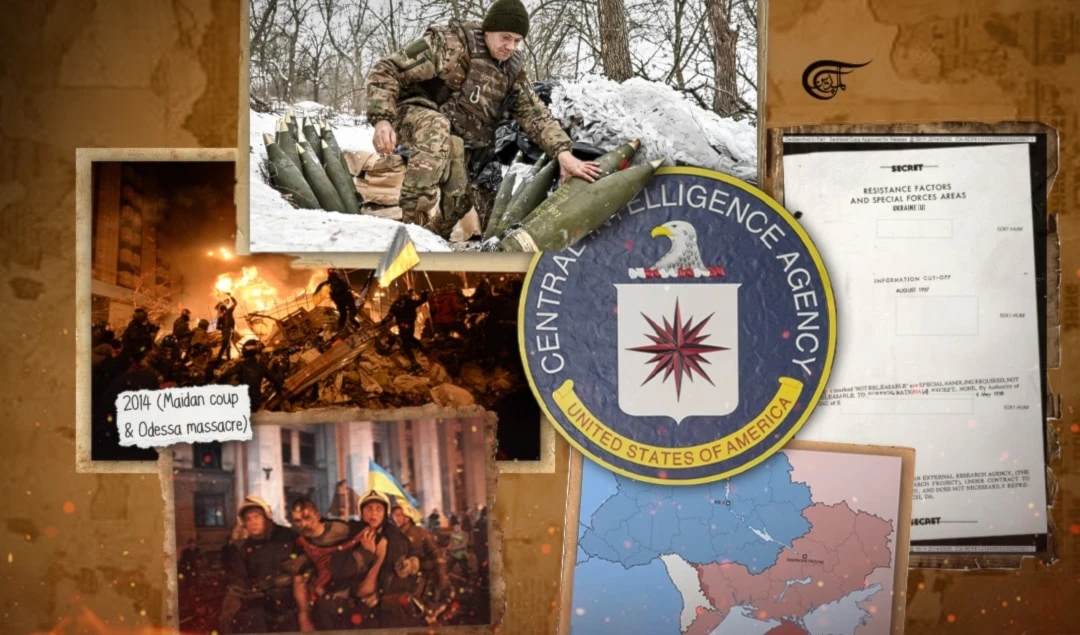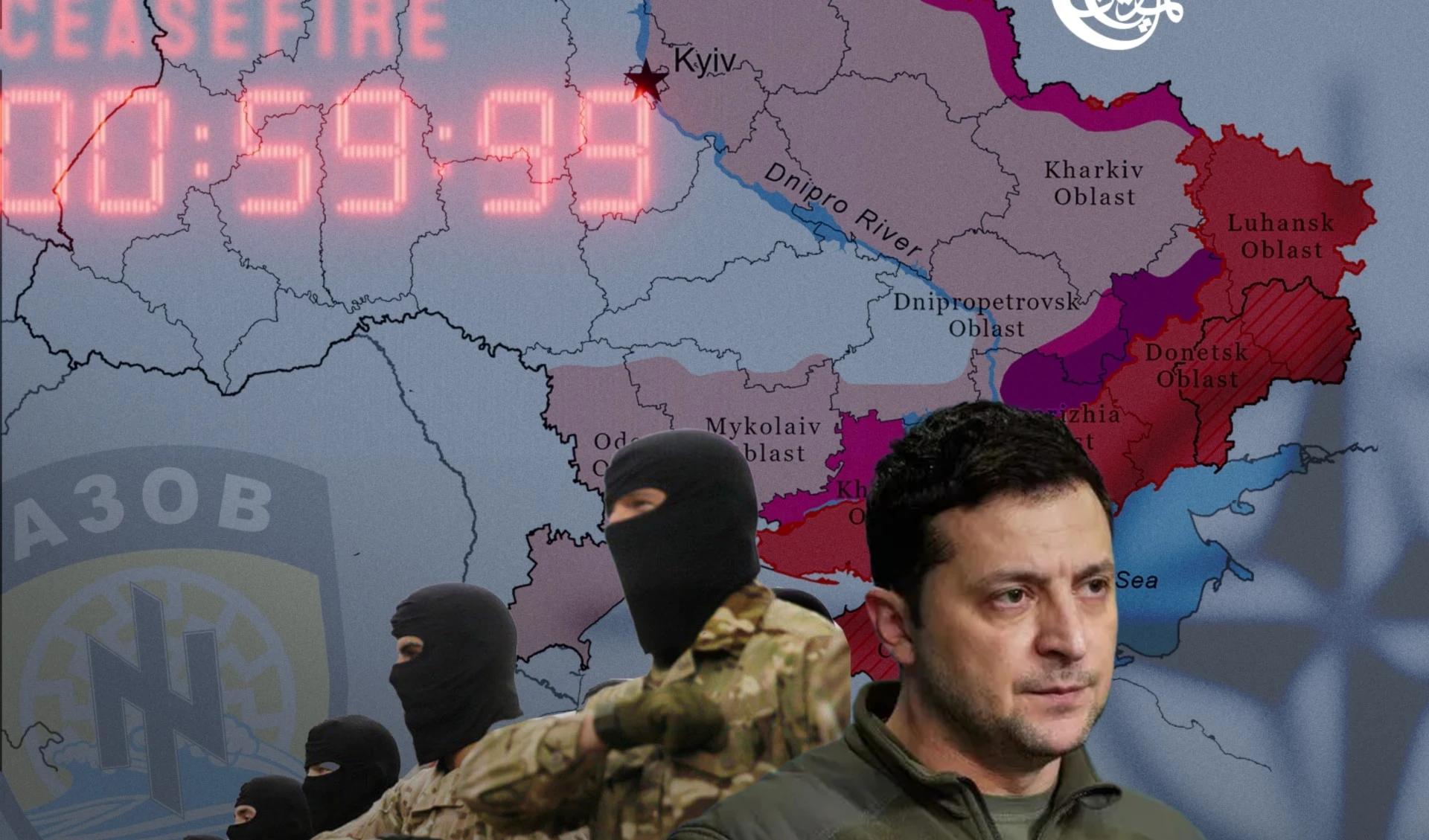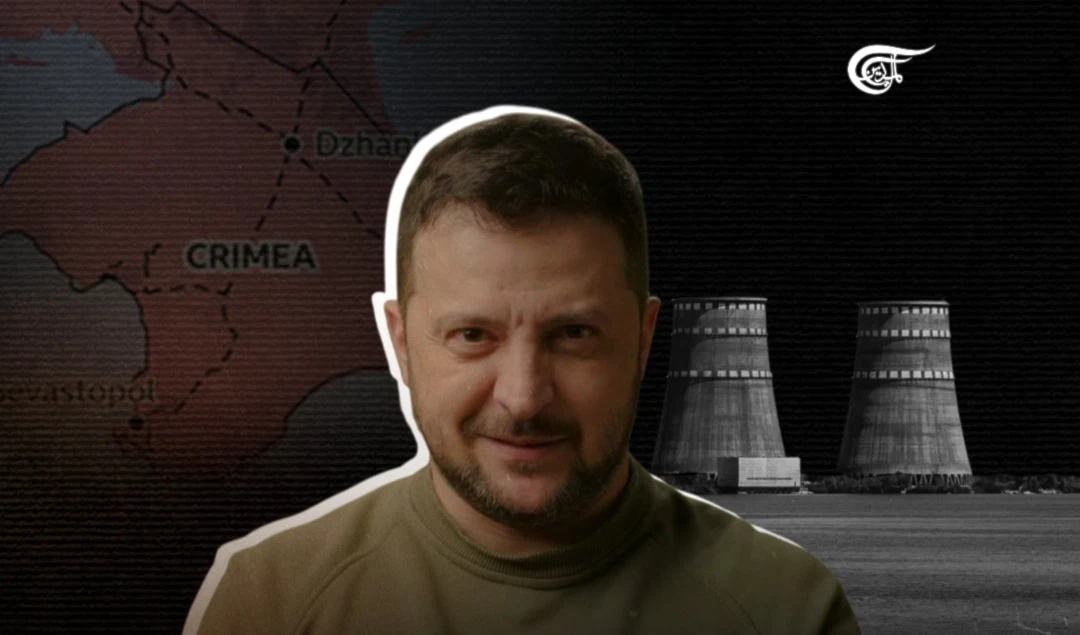The new ‘donor-nomics’ in Ukraine, thanks to Western governments and their taxpayers
Ukraine’s elite cling to Western aid, ignoring military collapse, while Zelensky pushes conflict with Russia and seeks to involve other countries to sustain his regime.
-

For Zelensky and his regime, a full-out war between Russia and NATO would be a welcome opportunity to preserve themselves in power and prolong their funding courtesy of obedient Western taxpayers (Illustrated by Mahdi Rteil to Al Mayadeen English)
In the second half of September 2025, military and political leaders in Ukraine are in unanimous agreement that the military situation in the country continues to deteriorate. But the public messaging by Kiev regime president Volodomyr Zelensky continues to insist that Ukraine will “win the war”.
Detached from reality
Foreign Policy magazine claims otherwise in a report published on September 16, headlined ‘Zelensky is losing touch with reality’. The report begins: “In the course of the last month, Ukraine’s government has pushed two significant measures related to one of its most glaring weaknesses: its strained armed forces. Yet its attempts to ease the strains have landed awkwardly in Ukraine, leaving some observers wondering whether President Volodymyr Zelensky and his circle of advisors are adequately in touch with reality beyond the corridors of power in Kiev…”
The discordance is noted by Ukrainians as well. “Zelensky has overstayed his president’s term and has lost touch with reality. We have no independent legislature governing us that could say ‘stop’, only the will of Zelensky. He believes himself to be the Churchill of our times, where everything is decided by him alone, together with a few of his ‘efficient’ managers,” writes Darya Kalenyuk on September 17. She is a journalist, a lawyer, and the executive director in Ukraine of the Center for Countering Corruption.
That same day, Ukrainian legislators and pro-regime analysts were gushing about the results of a closed meeting by Zelensky with his ‘Servant of the People’ political machine and other invited legislators on September 16. According to legislator Yaroslav Zheleznyak of the ‘Golos’ political faction, Zelensky told the meeting that his regime refuses to consider ceding any territory in the Donbas region to Russia. The regime continues to refuse any recognition of the expressed will of the people of the former Ukrainian oblasts (‘provinces’) of Lugansk and Donetsk since 2014 for either a meaningful autonomy within Ukraine or secession and joining the Russian Federation.
As later reported by Zheleznyak, Zelensky told legislators that the military situation in Ukraine “is developing normally” and Russian forces will eventually be defeated.
The people of the two former Ukrainian oblasts voted definitively in September 2022 to join the Russian Federation. For them and for the Russian government, the future is decided, and there is no going back. (Proposals were also approved at that time by referendum for affiliation to the Russian Federation by the people of the ‘new Russian territories’ of Kherson and Zaporizhzhia, south and east of the Dnieper River.)
According to Zheleznyak, Zelensky also told the closed meeting that people regularly complain about him to Western embassies, and the embassies then forward the complaints to him. If true, this is a remarkable description of how Western embassies act. It is not difficult to imagine the regime forwarding such complaints to its various police agencies.
Another participant in the meeting on September 16 was legislator Oleksandr Fedienko. He writes that Zelensky raised the topic of legislative elections. Fedienko also notes that whereas many observers are now predicting that an election will take place in Ukraine in the near future, Zelensky dismissed the idea at the meeting.
The last legislative and presidential elections to take place in Ukraine were in April 2019, for five-year terms. The electoral mandates of Zelensky and the Verkhovna Rada (legislature) thus expired a full 18 months ago.
Strana online media outlet reports on Telegram on September 17 about another legislator from Zelensky’s party who was present at the meeting, George Mazurashu. He said afterward, “Volodomyr Zelensky (along with others exempt from conscription) made it clear that he intends to fight to the last, but, of course, using other people to do the fighting.”
These days in Ukraine, such statements are considered simple statements of fact, considering that Zelensky and his entourage play no direct part in hostilities and thus face no direct threat to their lives. People also see and read in their words desperate attempts to prolong the war with Russia by involving other countries in the hostilities.
How to perpetuate Western funding for the Ukrainian elite
Meanwhile, the Ukrainian political elite is actively engaged in ensuring not so much the talked-about ‘security guarantees’ for Ukraine but guarantees of continued Western revenues (thus permitting the elite’s own, continued maintenance). This elite is continuously dreaming of how much it can continue to receive from Western ‘partners’ (that is, from the taxpayers of Western, ‘partner’ governments).
In mid-September, the Kiev regime’s cabinet of ministers presented a draft budget for the following year, and it once again envisions no spending on a national election, neither legislative nor presidential. The projected Ukrainian national budget for 2026 turns out to be not only record-breaking in expenditure but also extremely odd in failing to provide certain details.
The main oddity at the present time is a now-recognized ‘hole’ of some UAH300 billion (US$7.3 billion) in funding of military expenditure for the closing months of 2025. The ‘hole’ is due to sharp increases in payments being made to the families of soldiers killed or injured, so-called ‘coffin payments’. The duration of payments may now be extended to 80 months (6.5 years), during which time the Ukrainian currency is expected to be seriously devalued (and, most likely, a different government will be responsible for dealing with the entire mess of government funding and expenditure bequeathed by the Zelensky regime and its Western ‘partners’).
Social expenditures, including payment of pensions, the social costs of radical, ultra-nationalist policies, repairs of roads and other infrastructure, all these budget items are expected to be fully and completely financed by Western benefactors. That will mean, first and foremost, payments coming from the leading EU governments. These are already warning their populations to tighten their belts and expect big cuts to social spending.
The new phenomenon of ‘donor-nomics’ in Ukraine
On September 18, the former head of the Ukraine National Bank, Kyrylo Shevchenko, penned a new term for the economic model now firmly implanted in Ukraine, calling it ‘donor-nomics’. He writes that this is “a completely new type of economy and economic policy, completely dependent on external aid”. Its essence is a budget deficit of more than 20% of GDP, with this being covered not by internal resources but by external grants and loans.
“If in a conventional economy, the main goal is to create added value, under donor-nomics, the main goal is to maintain the confidence of donors so that each tranche of new funding may flow smoothly,” writes Shevchenko.
Legislator Yaroslav Zheleznyak admits that not only legislators in Ukraine but also appointed ministers are primarily engaged in creating projects that no one has the funding, nor perhaps even the intention to implement. Financing of projects is being determined by the whims and interests of donors, principally from Western governments.
Zheleznyak says that for six years (since 2019), Ukraine has been overwhelmed with high-profile strategies and programs for change, but these have remained “on paper” only. Authorities have presented more than 20 state programs during these six years, ranging from national security, including cybersecurity, to regional development. But none of them has ever been realized in real life. “These programs exist only in promises, presentations, and press releases by officials. In practice, citizens do not see any changes and improvements in life,” the legislator writes, stressing that what happens instead are “political imitations” of real projects. He calls this “imitation of work”.
The problem for the regime is that the political and economic elite of Ukraine can only continue receiving Western funding so long as it is actively fighting Russia, or pretending to do so. Without this, the entire Ukrainian elite would be deprived of its main sources of income and left alone to deal with a plundered and war-torn country whose economic future is already owed to governments and financial institutions of the wealthy, imperialist world.
In the face of this grim outlook, legislator Oleksandr Dubynskyy believes that a scenario becomes quite realistic in which Ukraine, disappointed with Europe, turns to a resumption of economic relations with Russia.
Russian analysts and politicians have long expressed that they are tired of this tactic as used by the ruling elites of post-Soviet republics, so much so that they did not mind if the exorbitant appetites of former Soviet leaders were satisfied by Western governments and their taxpaying base in the years following 1990/91.
Desire to draw Poland into the conflict
As the situation on the front lines in late September continues to deteriorate for Ukraine, new incidents and provocations against Russia have multiplied, with the aim of drawing more countries into the conflict. In particular, an alleged entry of two dozen Russian drones flying into Polish airspace late on September 9 (local time) has been actively used for this purpose. The drones were not armed and did not cause any casualties or destruction. The one dwelling that was damaged was hit by a Polish missile aimed at some of the drones.
One of the images of an offending Russian drone shows a Russian Gerbera imitation drone normally used for air defense distraction resting neatly on the roof of a chicken coop. Had it fallen, the drone would have destroyed the roof at the very least. The photo also shows the nose of the drone wrapped in duct tape. Russian factories produce such disposable drones by the thousands; they are never reused nor repaired with duct tape or anything similar because there is no way to repurpose them, and certainly no use of duct tape to make repairs. The pictured drone is obviously one that previously fell somewhere in Ukraine and was then repaired and reused for the purpose of simulating a ‘Russian incursion’. In other words, the drone looks like a poorly prepared, false-flag provocation.
Despite the flimsy evidence of Russian drones over Poland, the entirety of Ukrainian media and political leaders have been clamoring ever since, calling upon the Polish government to mount a military response and join the military conflict with Russia. For his part, Zelensky has sought to tap into the vanity of Poles by saying that the Russian government and military are seeking to humiliate Poland.
Ukrainian-Israeli expert Yigal Levin, who works for the Ukrainian defense ministry's intelligence service, is further inflaming the situation by claiming that the drones flown into Poland were aimed at American soldiers stationed in Rzeszów, Poland.
Ukrainian Foreign Minister Andriy Sibiga is demanding that foreign militaries engage in shooting down Russian drones over Ukrainian territory. The aim is to frighten Poles with messaging that “a weak response now will provoke Russia even more, and then Russian missiles and drones will begin flying further into the depths of Europe.”
Escalate the West’s proxy war against Russia?
In an interview with Sky News on September 16, Zelensky said that the countries of Europe and the United States should stop “thinking about themselves” and their future relations with the Russian Federation and think more about Ukraine. In essence, he is demanding that the West sacrifice its interests and those of its citizens for the sake of preserving Zelensky’s shaky hold on power.
Trump's special envoy to Ukraine, Keith Kellogg, who is considered one of Kiev's closest friends in the West, is encouraging Zelensky to escalate the West’s proxy war against Russia. He attended the annual meeting in Kiev on September 13 of the ‘Yalta European Strategy’ (‘YES’) foundation. “We had a discussion about the ‘primacy’ of the Russian military, and I said, ‘we would kick their ass together’,” Kellogg told reporters there. (This is hardly the language of a U.S. presidency seeking ‘peace’ with Russia, as many Western analysts falsely describe the Trump-led war regime in Washington.)
The Ukrainian Telegram channel Legitimny believes that Kiev itself launched drones into Poland in order to increase anti-Russian sentiment there and in the wider world. It says the drone story serves as a means to demand ever more money for waging war against Russia (with the acknowledged US$3.2 billion ‘hole’ in military support payments for 2025 no doubt in mind).
Former Polish President Andrzej Duda recently acknowledged that Ukraine has been trying to drag Poland into a war with Russia since 2022. “It's in their interest to drag everyone into war, and it would be especially good for them if they managed to drag NATO countries into the war... This is not news. It has been happening since the first day [of the Russian military operation],” the former president said in an interview.
Furthermore, as Polish Prime Minister Donald Tusk wrote on September 14, a ‘troubling’ wave of pro-Russian sentiment and hostility toward Ukraine is currently growing in Poland. Tusk blames Moscow for the growth of these sentiments (as though the Russian government has some mystical hold on the hearts and minds of the Polish people).
Oleg Jasinski, a Ukrainian journalist writing from abroad, also believes that the ‘Russian drone raid’ story serves one side in the conflict very well, that being the same side which became terribly upset about the two-day summit meeting of the Shanghai Cooperation Organization in Tianjin, China on August 31/September 1. There, the Russian government's role was front and center, and the government of India was a participant. According to Jasinski, the West’s only salvation from military and political defeat in Ukraine is an escalation of direct participation by all of Europe’s governments and militaries.
The Polish Gazeta Wyborcza writes that many Poles have begun looking for residences abroad following the claimed drone incident on September 9. The newspaper says the number of applications from Poland to buy real estate in Spain has tripled.
Strana wrote on September 15 that Poles themselves and their economy do not need a war, as Poland is now one of the fastest-growing economies in the European Union.
“In addition,” Strana writes, “everyone in recent years has been able to see, repeatedly, that Polish attitudes to Ukraine and Ukrainians are, to put it mildly, ambiguous. They are not at all very eager to join the fighting in Ukraine.” Despite this, Strana notes, the topic of Poland's entry into the war is constantly being discussed by certain media and Western political leaders.
The Russian Federation does not need a conflict with Poland. It doesn’t need a ‘second front’ because a significant part of the Russian army is already deployed in Ukraine.
Strana also recalls that there is a widespread theory in Ukraine that the Western ‘party of war’ is seeking to involve certain European countries directly in the war with Russia on the side of Ukraine, but they would choose to do so outside the framework of NATO so that it would not look like a direct NATO war against Russia. Russian officials are not fooled. They have stated that direct military intervention by NATO countries in Ukraine, even at the level of a ‘no-fly’ zone over the country, would cause war with the NATO bloc.
For Zelensky and his regime, a full-out war between Russia and NATO would be a welcome opportunity to preserve themselves in power and prolong their funding courtesy of obedient Western taxpayers.

 Dmitri Kovalevich
Dmitri Kovalevich
 14 Min Read
14 Min Read












